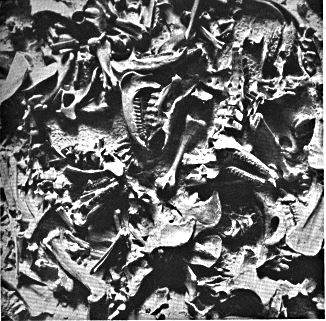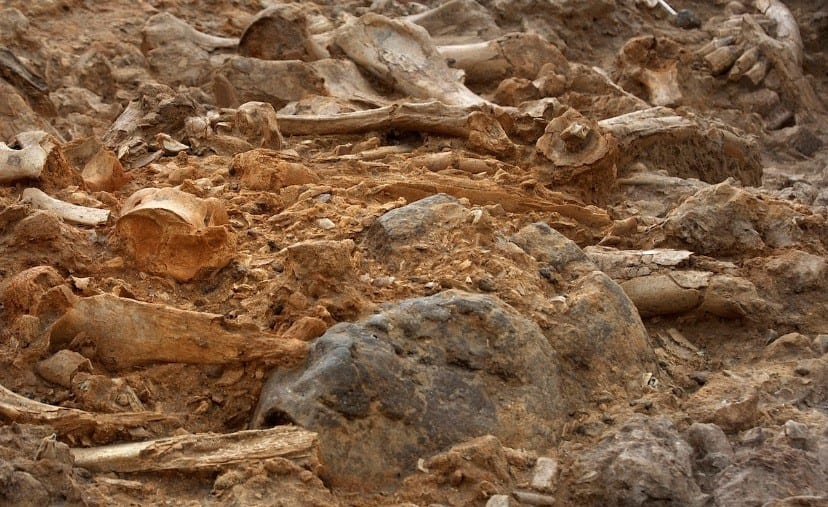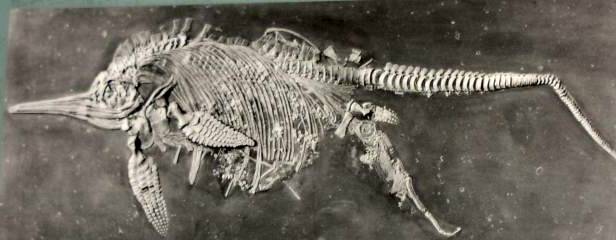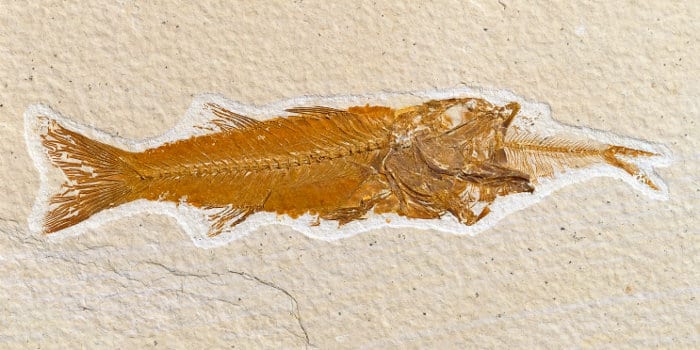Imagine what would have been happening to the surface of the earth during the violent events of Noah’s Flood.[1] The whole land would have been covered by water; trees and other plants would have been ripped out of the ground, they even covered the Antarctic at the time, producing great floating mats of vegetation. At the same time the fountains of the great deep burst forth.[2] The whole of the earth’s surface convulsed as the earth’s crust broke apart, mountains rose and the ocean floor sunk in various places. Over the land great waves of mud would have crashed and instantly buried their contents of ocean and land dwelling creatures, along with vegetation and insects. Vast herds of animals would have gathered on high ground to escape the approaching flood waters only to have been instantly entombed by an approaching mountain of mud, which would have produced massive fossil graveyards.
If an animal dies today, it will not become a fossil. Within a very short time, carnivores will carry bits of its body away, birds of prey will be picking the bones clean, smaller scavengers such as rats, mice, beetles and ants will be taking what they can and, finally, micro-organisms will break down the remains. Thus, in a matter of months, the beast will have disappeared, with the possible exception of a few bones. Fossil graveyards could have only been formed by catastrophic burial and are a huge problem for evolutionists who think that the fossil graveyards were formed over vast eons of time. Here are a few:
Fossil graveyards
 Agate Spring,Nebraska is a fossil graveyard containing 9,000 animals buried in alluvial The remains of camels, three-toed horses, rhinoceroses, giant wild boars, birds, plants, trees, seashells and fish are all scrambled together. The image to the right is a very small part of the fossil graveyard.
Agate Spring,Nebraska is a fossil graveyard containing 9,000 animals buried in alluvial The remains of camels, three-toed horses, rhinoceroses, giant wild boars, birds, plants, trees, seashells and fish are all scrambled together. The image to the right is a very small part of the fossil graveyard.- Gobi Desert. This area of Central Asia is one of the driest places on earth, yet it is a paradise for paleontologists and consequently has been labeled a fossil “Valhalla” due to its stunning dinosaur discoveries. One of particular interest is a nest and eggs with an Oviraptor (small Mongolian theropod dinosaur) still crouched on it thereby providing strong evidence for a rapid and cataclysmic burial. So far, 25 therapod dinosaurs and 200 skulls of mammals, along with other dinosaurs, lizards and small mammals have been unearthed, in an amazing state of preservation. Gobi holds the world’s richest and most diverse deposits of dinosaur and mammal remains.
- The Ashley Bedsis an area of phosphate bed comprising 100 square kilometers (40 square miles), located in South Carolina USA. It was first mentioned by Major Edward Willis in his book Fossils and Phosphate Specimens, which was published in 1881. It contains the remains of both land and sea animals—dinosaurs, plesiosaurs, whales, sharks, rhinoceroses, sheep, horses, mastodons, mammoths, porpoises, elephants, deer, pigs and dogs.[3]
- Montceau-les Mines. The mine is near Autun in France. Its fossils are well preserved and in excellent condition. As well, they consist of a mixture of creatures. Some are lived in saltwater, some in freshwater and some are land-based animals. For example, hundreds of thousands of marine creatures were buried with amphibians, reptiles and insects. Spiders, scorpions and millipedes were found as well. The find was reported in Scientific American[4] and the two palaeontologists working on the site; Daniel Heyler and Cecile Poplin, were bewildered by the mixture and variety of animal fossils present. The mixture is not bewildering if Noah’s Flood actually happened.
 West Coast Fossil Park, Langebaanweg, South Africa is another collection of bones. In this case many thousands of different creatures were buried rapidly including; giant wild pigs, over 40 species of aardvarks, numerous long-necked and short-necked giraffes, 5 different species of hyena, an extinct hippopotamus, a three-toed horse, 3 species of elephant, bontebok antelopes, a sabre-tooth cat, an African bear, mice, mole rats, frogs and lizards, plus 90 different species of birds, seals, whales, megalodon sharks and many more.[5]
West Coast Fossil Park, Langebaanweg, South Africa is another collection of bones. In this case many thousands of different creatures were buried rapidly including; giant wild pigs, over 40 species of aardvarks, numerous long-necked and short-necked giraffes, 5 different species of hyena, an extinct hippopotamus, a three-toed horse, 3 species of elephant, bontebok antelopes, a sabre-tooth cat, an African bear, mice, mole rats, frogs and lizards, plus 90 different species of birds, seals, whales, megalodon sharks and many more.[5] The Karoo Formation. Another massive repository of fossils is found in South Africa. Fossils include plants, pollen, insects, fish, tetrapods, reptiles, amphibians and dinosaurs.[6] The exact number of creatures buried is open to speculation. However, one can safely assume over 40,000.[7]
The Karoo Formation. Another massive repository of fossils is found in South Africa. Fossils include plants, pollen, insects, fish, tetrapods, reptiles, amphibians and dinosaurs.[6] The exact number of creatures buried is open to speculation. However, one can safely assume over 40,000.[7]
Such large deposits of mixed animal, aquatic and avian fossils spread throughout the world provides clear evidence of large scale violent and rapid burial. One plausible explanation for their existence, is that they were all created by a single catastrophic event, so rapid that some creatures were buried in the act of eating and giving birth.
This is exactly what would be expected as the result of a Noah’s Flood.
[1] Genesis chapters 6-8.
[2] Genesis 7:11.
[3] genesispark.org/genpark/grave/grave.htm, retrieved April 9, 2011.
[4] Scientific American, September 1988, 256, pages 70–76.
[5] Creation, Volume 38, No 3, 2016, page 38-39.
[6] https://en.wikipedia.org/wiki/Karoo_Supergroup.
[7] http://www.rae.org/pdf/800Billion.pdf.



